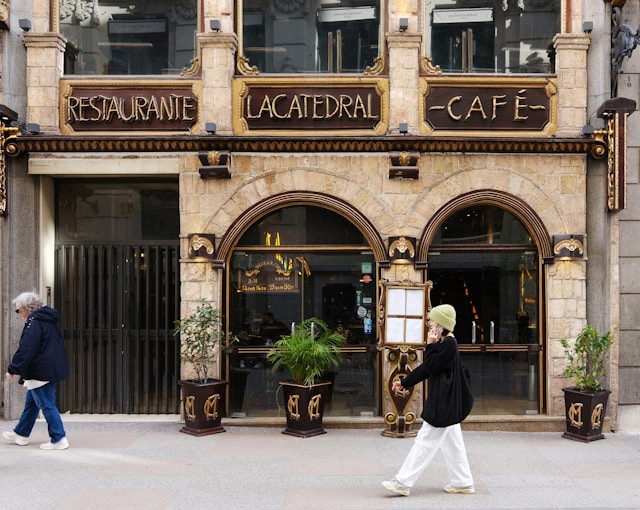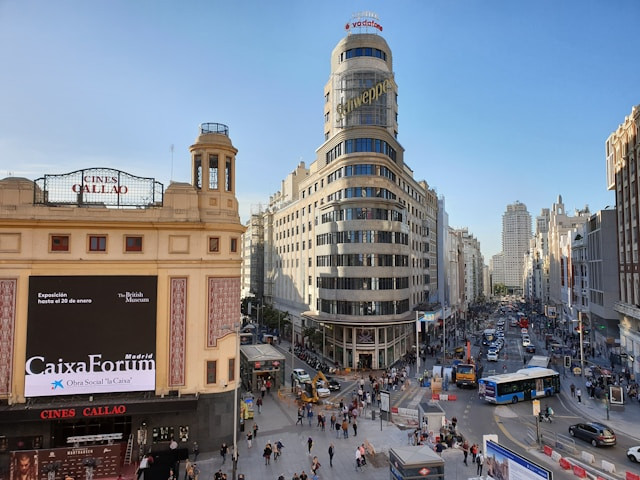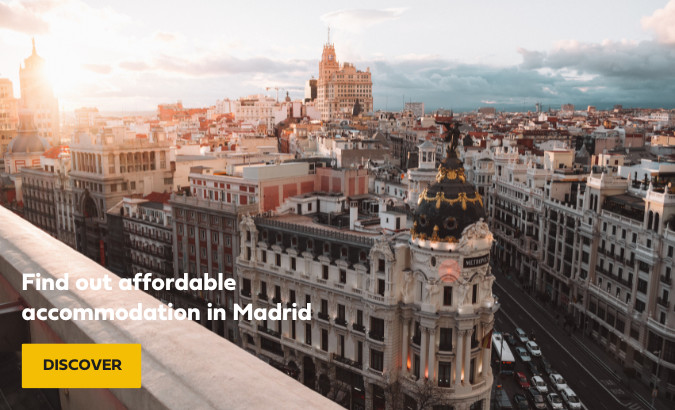The capital of Spain, Madrid, is a sought-after destination for digital nomads who look for a mix of history, rich culture, and modern amenities. Famous for its lively streets, diverse cuisine, and world-class museums, Madrid is the place where you can experience the old and the new.
- Why Madrid?
- Best time to visit
- Visas
- Accommodation
- Cost of living
- Itineraries
- Co-working spaces
- Public places for remote work
- Must-try dishes
- Transportation
- Essential services
- Top activities
- Networking
- Best neighborhoods
- Top places to visit
- Tips for digital nomads
- Basic phrases in Spanish
- FAQs
- Other useful information
With reliable, fast Wi-Fi, a large number of coworking spaces, and a growing international community, it’s an ideal choice for remote workers who are in search of a European base.
In this guide, we’ll cover the most essential information you need to know about living and working remotely in this city, from accommodation for rent in Madrid to the Spain digital nomad visa to the cost of living.
Why Madrid?
In Madrid, digital nomads can experience an unbeatable lifestyle. As Spain’s largest city, the city is a cosmopolitan hub characterized by a laid-back attitude. The architecture, from modern skyscrapers to royal palaces, reflects its dynamic spirit.
Madrid also has one of the best transport systems in Europe, which makes it quite easy to explore the city and surrounding regions.
For those who are interested in networking, Madrid’s digital nomad community and international population are growing and thriving, and you’ll find various opportunities for social and professional connections.
Find cheap apartments for rent in Madrid
Best time to visit Madrid
Madrid has a Mediterranean climate, which is characterized by cool winters and hot summers. Here’s what you can expect throughout the year:
Spring (March to May)
Pleasant temperatures, typically between 12°C and 22°C, which is suitable for outdoor activities, sightseeing, and enjoying parks.
Summer (June to August)
Dry and hot, with temperatures that reach up to 35°C. It is a quieter time because many locals go on vacation, and air-conditioned coworking spaces and cafes make it manageable.
Fall (September to November)
Comfortable and mild, with temperatures often between 15°C to 25°C. This is one of the most pleasant times to visit the city, with beautiful weather and fewer tourists.
Winter (December to February)
Cool but not freezing, with temperatures usually between 5°C and 12°C. Though quieter, Madrid’s festive atmosphere and cozy cafes make it an ideal time for nomads who prefer fewer crowds.

Source: Photo by Alvaro Araoz on Unsplash
Visas
Spain, like other countries in the Schengen area, offers several visa options for nomads:
Schengen visa
Citizens of non-EU countries are allowed to stay in Spain for up to 90 days in a 180-day period without a visa, perfect for short-term visits.
Digital nomad visa
Spain launched its digital nomad visa in 2023, allowing remote workers to stay and work in the country legally for up to a year, with the possibility of renewal.
Non-lucrative visa
This visa is a popular option for individuals who intend to stay longer than 90 days but not work for a Spanish company. The requirements include proof of sufficient funds or passive income.
Make sure to check specific requirements for different kinds of visas based on your nationality.
Accommodation in Madrid
Madrid has a wide, diverse range of accommodation on Spain that suit different budgets and needs, whether you’re staying long-term or short-term.
Accommodation types
- Short-term rentals: Suitable for nomads staying a couple of weeks or months. Look for furnished apartments in central areas for convenience.
- Long-term rentals: Available for those who plan to stay six months or longer. You can find all kinds of housing in Madrid, from studios to larger flats, depending on your requirements, lifestyle, and budget.
- Co-living spaces: Co-living is becoming more and more popular in Madrid, offering shared accommodation with a community vibe and typically gym and modern coworking spaces included.
Rent prices in Madrid
The cost of rent in Madrid varies based on the neighborhood and accommodation type. Here’s a general overview of rental prices:
- Shared apartments: €350-€700 a month.
- Studio apartments: €700-€1,000 a month.
- One-bedroom apartments: €900-€1,300 a month.
- Two-bedroom apartments: €1,200-€1,800 a month.
Central neighborhoods such as Chueca and Malasaña are obviously more expensive, while areas like La Latina and Lavapiés feature more affordable options.
Flatio: Flexible, deposit-free stays in Madrid
Are you looking for flexible, reasonably priced, and deposit-free stays in Madrid? Take a look at the listings on Flatio and we believe you will find a suitable living space in the city center and beyond.
Cost of living in Madrid
Madrid is relatively more affordable than many other capitals in Europe, though slightly more expensive than other cities in Spain. Here’s an overview of typical expenses per month for a digital nomad:
- Accommodation: €700-€1,500
- Food & groceries: €250-€400
- Transportation: €55 (monthly metro/bus pass)
- Coworking spaces: €100-€250
- Leisure & miscellaneous: €150-€300
With a budget of about €1,500-€2,500 per month, you can live a decent life in Madrid.
Itineraries
3 days
- Day 1: Discover Puerta del Sol and Plaza Mayor, visit the Royal Palace, and enjoy a stroll through the scenic Sabatini Gardens.
- Day 2: Enjoy Retiro Park, visit Museo del Prado, and check out the world-famous Puerta de Alcalá.
- Day 3: Go to Gran Vía for shopping, then head to La Latina for tapas and a lively nightlife.
1 week
- Days 1-3: Follow the 3-day itinerary.
- Day 4: Go on a day trip to Toledo, a medieval city located just 30 minutes from Madrid by train.
- Day 5: Visit Thyssen-Bornemisza Museum and Museo Reina Sofia for modern art lovers.
- Day 6: Spend the day in Chamberí, discover Sorolla Museum, and explore the local markets.
- Day 7: Visit Chueca and Malasaña, trendy neighborhoods with great cafes, boutiques, and bars.
1 month
- Week 1: Settle in by exploring Madrid’s main attractions like Plaza Mayor, Royal Palace, and Retiro Park.
- Week 2: Take day trips to cities like Toledo, Segovia, and Ávila that are not far from Madrid.
- Week 3: Dive deeper into the city’s local life by exploring food markets such as Mercado de San Miguel and discovering lesser-known neighborhoods like La Latina and Lavapiés.
- Week 4: Enjoy the cultural scene in the capital by enjoying a concert at Teatro Real, exploring art galleries, or attending language exchange meetups.
3 months
- Month 1: Get to know the neighborhoods of Madrid better, visit the top museums, and enjoy the local culture.
- Month 2: Work on professional or personal projects, while also taking time to discover more of Spain with visits to Seville, Valencia, or Barcelona.
- Month 3: Build connections and expand your network in the city by participating in nomad meetups, and attending cultural workshops or events.

Source: Photo by 야스민 ㄹㅁㅅ on Unsplash
Co-working spaces in Madrid
Madrid hosts a growing number of coworking spaces, catering specifically to freelancers, remote workers, and entrepreneurs.
Here are some of the top options:
- Impact Hub Madrid: A popular coworking network that has multiple locations around Madrid, offering a lively community and flexible memberships.
- Utopicus: Known for its central locations and sleek design, suitable for professionals who are looking for a stylish workspace.
- Espacio Geranios: A cozy coworking space that’s located in La Latina, ideal for remote workers who need a collaborative yet quiet environment.
Public places for remote work
If you prefer public spaces for remote work, Madrid has many libraries and cafes that are perfect for getting work done:
- Cafés:
- Federal Café: A popular spot for remote workers with free Wi-Fi and a laid-back atmosphere in Malasaña.
- Café de la Luz: A cozy cafe in Chueca, perfect for working with a laptop and enjoying great coffee.
- La Bicicleta: A trendy spot that’s a favorite among freelancers in Malasaña, with strong Wi-Fi and a creative vibe.
- Libraries:
- Biblioteca Nacional de España: A historic library with quiet reading rooms and free Wi-Fi.
- Biblioteca Pública Municipal Eugenio Trías: Located in Retiro Park, this library is great for working in a peaceful setting.
Must-try dishes in Madrid
Madrid’s culinary scene is diverse and delicious, offering all kinds of dishes, from traditional Spanish tapas to international cuisine.
Some must-try ones include:
- Cocido Madrileño: A hearty stew made with vegetables, chickpeas, and meats. It’s a traditional winter dish, which is sure to fill you up.
- Bocadillo de Calamares: A sandwich that’s filled with fried calamari and is served in many of the old-fashioned taverns in Madrid.
- Tortilla Española: A classic Spanish omelet that’s made with eggs and potatoes, often served as a tapa.
- Churros con Chocolate: Crispy fried dough, which is served with thick hot chocolate and is great for dessert or breakfast.
- Callos a la Madrileña: A stew that’s made with chorizo, beef tripe, and blood sausage and is often served with crusty bread.

Source: Photo by Dmitrii Eliuseev on Unsplash
Transportation in Madrid
The public transport system in Madrid is reliable, extensive, and affordable.
- Metro: One of the fastest, most affordable ways to get around Madrid, with 13 lines covering most areas.
- Buses: Madrid’s buses are an excellent option for places that are not served by the metro. They run frequently and are well-maintained.
- Trains: Madrid’s Cercanías commuter trains link the city to nearby towns and suburbs, ideal for day trips.
- Taxis & ride-sharing: Taxis are widely and readily available, and ride-sharing apps are convenient and popular.
- Walking: Many of the capital’s top sights are within walking distance of each other, which makes walking a great option, particularly in the central districts.
Essential services
- Healthcare: Spain has a great healthcare system. For those who plan to stay long-term, private healthcare plans offer faster service and are affordable.
- SIM cards: Buy a local SIM card with data at a phone store. Prices typically start from €10-€20 for a monthly data plan.
- Post offices: There are many post offices in Madrid, including a central one close to Cibeles. Expect efficient service for mailing letters and packages.
Top activities in Madrid
In Madrid, you can engage in a variety of activities to keep you entertained:
- El Retiro Park: Relax in the capital’s most famous park, complete with shaded gardens and a boating lake.
- The Prado Museum: It hosts thousands of European artworks, such as masterpieces by Goya and Velázquez.
- Royal Palace: Visit the official residence of the Spanish Royal Family to learn about regal history.
- Gran Vía: Madrid’s most well-known shopping street, which is lined with theaters, shops, and restaurants.
- Flamenco show: Enjoy an authentic flamenco performance at one of Madrid’s many tablaos (flamenco venues).
Find perfect apartments for rent in Spain
Networking
Madrid’s expat and nomad communities offer lots of opportunities to socialize, and network:
- Coworking events: Co-working spaces such as Impact Hub regularly host networking events, social gatherings, and workshops.
- Meetups: Platforms such as Meetup.com feature a wide range of events, from professional workshops to language exchanges.
- Facebook groups: Join digital nomad or expat groups on Facebook to connect with like-minded individuals and learn about events happening in the city.
Best neighborhoods in Madrid
Each neighborhood in Madrid has a unique character, catering to different preferences and lifestyles:
- Malasaña: A lively and hip area that’s filled with cool cafes, street art, and coworking spaces. Popular among younger creatives and digital nomads.
- Chueca: Famous for its lively and inclusive atmosphere, Chueca hosts some of the city’s best LGBTQ+ friendly and nightlife spaces.
- La Latina: A historic neighborhood with narrow streets, a bohemian vibe, and traditional tapas bars.Ideal for those who want to get to know the local culture.
- Lavapiés: Madrid’s multicultural hub, offering affordable rental prices, a variety of international cuisine, and a thriving arts scene.
- Salamanca: One of the city’s more upscale neighborhoods, with high-end restaurants, shops, and elegant architecture.

Source: Photo by Spencer Davis on Unsplash
Top places to visit in Madrid
Make sure to visit these iconic sights while you’re in Madrid:
- Plaza Mayor: The grand central square, great for soaking in the city’s history and people-watching.
- Royal Palace of Madrid: One of Europe’s largest palaces in Europe, which is open for tours of the royal apartments and gardens.
- El Retiro Park: A vast green space in the heart of Madrid, great for a relaxing day or outdoor activities.
- Puerta del Sol: The symbolic center of Madrid. It’s where you can find the statue of the Bear and the Strawberry Tree and the famous Kilometer Zero plaque.
- Temple of Debod: An ancient Egyptian temple donated to Spain. It offers picturesque sunset views over the city.
Tips for digital nomads
Language
While many people in Madrid speak English, especially in touristy areas, learning some basic phrases in Spanish helps you have a more pleasant experience.
Weather
Summers in Madrid can be extremely hot, so make sure to plan accordingly. Winters are mild, but they can be chilly, particularly at night.
Currency
Spain uses the Euro (€). Most places accept credit cards. However, it’s a good idea to have some cash wish you, as smaller establishments may prefer cash.
Safety
Madrid is considered to be generally safe. But as with any main city, it’s advisable to watch your belongings, especially when you’re in crowded areas.
Electricity
To stay in Spain, use Type C and F plugs, with a standard voltage of 230V.
Basic phrases in Spanish
Learning a few basic Spanish phrases will help you get by:
- Hola! – Hello
- Buenos días! – Good morning
- Gracias – Thank you
- Por favor – Please
- ¿Cuánto cuesta? – How much does it cost?
- ¿Dónde está el metro? – Where is the metro?
- ¿Hablas inglés? – Do you speak English?
 Source: Photo by Giuseppe Buccola on Unsplash
Source: Photo by Giuseppe Buccola on Unsplash
FAQs
- Is Madrid an affordable destination for digital nomads?
Yes, compared to other major cities in Europe, Madrid offers a relatively affordable cost of living. You can experience a decent life on a budget of €1,500-€2,500 per month. - Do I need to speak Spanish to be able to live in Madrid?
While you can get by with English in a lot of areas, especially touristy ones, learning some basic Spanish can enhance your overall experience and help you connect with locals. - Can I work remotely in Madrid if I hold a tourist visa?
Yes, for stays up to 90 days, you’re allowed to work remotely in Madrid on a Schengen tourist visa. For longer visits, consider applying for the Spain digital nomad visa.
Other useful information
- Time Zone: Central European Time (CET), GMT+1. It’s GMT+2 during daylight saving time.
- Currency: Euro (€).
- Tipping: Tipping 5-10% in restaurants is common. However, it’s not mandatory.
- Emergency number: Call 112 for emergency services.
- Electricity: Spain uses Type C and F plugs, with a standard voltage of 230V.
Flatio: Rental accommodation in Madrid
Why choose Flatio to rent accommodation in Madrid? Discover the unique features that make us the perfect choice:
- Flexible, reasonably priced stays (from days to months)
- Wide range of accommodation options (rooms, apartments, houses, etc.)
- Utilities and Wi-Fi included
- Visa-friendly lease agreements
- Online signing of lease agreement
- Renting directly from hosts
- No deposit required for stays under 180 days (unless required by local laws)
- Balanced lease agreement, translated into multiple languages
- Very attractive cancelation policy
- StayProtection for Tenants: assistance with emergencies and accidental property damage
- Move-in Guarantee with a 24/7 emergency line
- 100% money protection
- Customer support available every day of the week
- No hidden fees
- Secure and simple payment system, including Bitcoin option
COVER IMAGE: Source: Photo by Carlos Zurita on Unsplash


